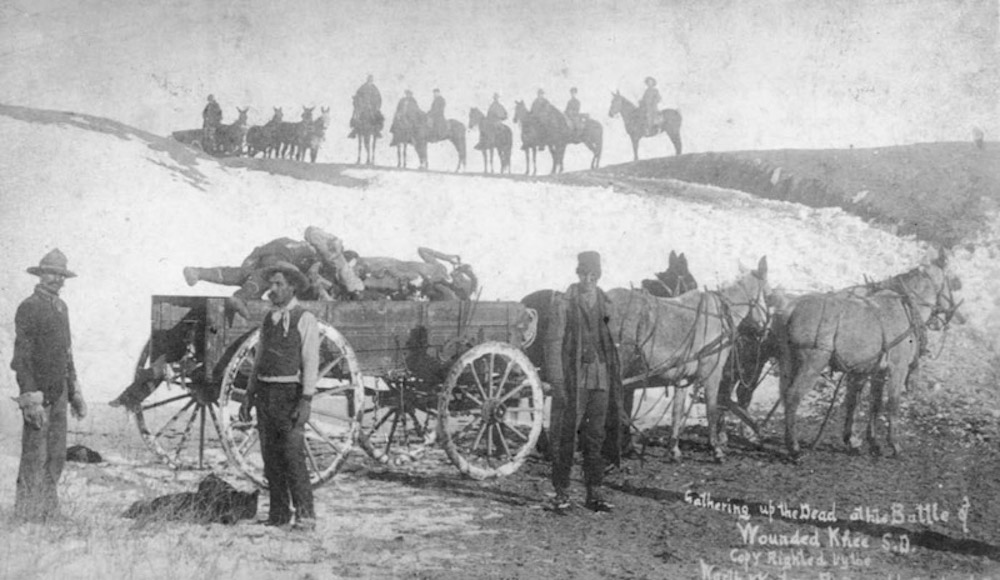
- Details
- By Gabriel Pietrorazio, The War Horse
When Rep. Kaiali’i Kahele, a lieutenant colonel in the Hawaii Air National Guard, thinks about the men, women, and children massacred by the U.S. Army more than a century ago at Wounded Knee, it brings home memories of other wrongs.
In 1893, U.S. Marines helped stage a coup d’etat with American sugar planters against Queen Lili’uokalani, the Hawaiian monarch. Their actions in overthrowing her kingdom eventually led the cluster of islands to become the last state, through annexation, to join the United States.
“No redress has ever happened,” Kahele says, though Congress eventually apologized.
So when Native American veterans came to Kahele, who is on the House Armed Services Committee, with a mission to save the honor of Indigineous peoples, as well as of the Medal of Honor, he committed to their cause.
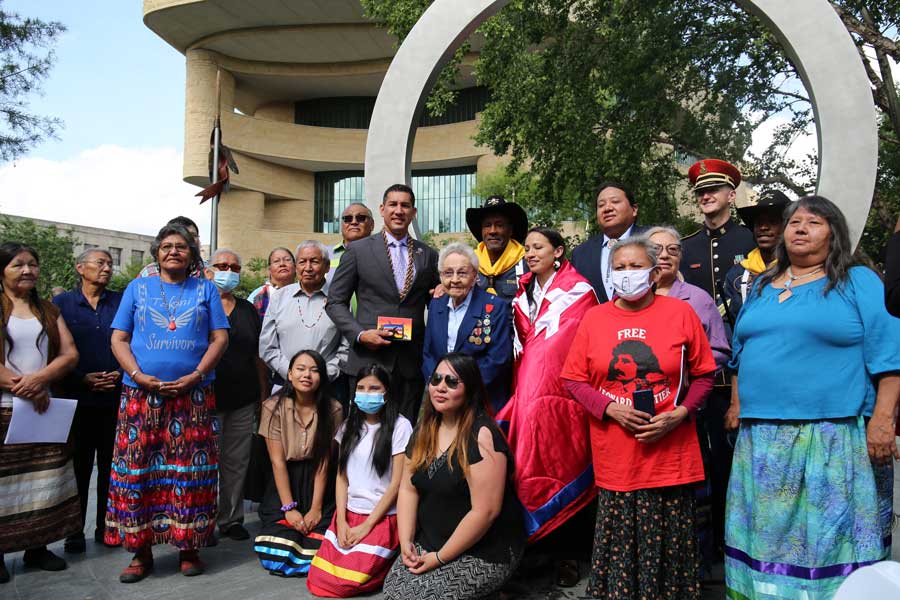 Rep. Kai Kahele, D-Hawaii, stands with Wounded Knee descendants in front of the National Native American Veterans Memorial outside the Smithsonian National Museum of the American Indian in Washington. (Photo courtesy of Rep. Kai Kahele.)
Rep. Kai Kahele, D-Hawaii, stands with Wounded Knee descendants in front of the National Native American Veterans Memorial outside the Smithsonian National Museum of the American Indian in Washington. (Photo courtesy of Rep. Kai Kahele.)
“As a Native Hawaiian, as a combat veteran, I’m a very proud member of our United States military,” he says. “And the Medal of Honor is our nation’s highest military honor that honors heroism and bravery. … But what happened at Wounded Knee and the massacre of hundreds of unarmed Native Americans tarnishes the integrity of the Medal of Honor and stains the reputation of those who do live up to the standard of the Medal of Honor.”
Kahele—and a coalition of veterans, ancestors, and lawmakers—hopes to rescind the 20 Medals of Honor awarded after the attack.
That push began in 2019, when Donald Trump mocked Sen. Elizabeth Warren, saying the Democratic senator from Massachusetts should have filmed her 2019 New Year’s Eve announcement to establish a presidential exploratory committee while standing in front of a backdrop of “Bighorn or Wounded Knee, instead of her kitchen, with her husband dressed in full Indian garb.”
“I mean, when the president of the United States doesn’t even know about Wounded Knee and can use it as a racist joke,” says Oliver “O.J.” Semans Sr., an enrolled member of the Rosebud Sioux Tribe and a former U.S. Navy firefighter, “that means we have a long ways to go in order to teach America what actually happened at Wounded Knee, so that’s when we started the campaign.”
Semans wrote a letter to Trump less than a month after the president’s remarks but said it wasn’t meant to “explain the wrong done in invoking this horror”—since his senators had already done so.
“It should never be used as a punchline,” South Dakota Republican Sen. Mike Rounds tweeted. Sen. John Thune, a member of the Senate Republican leadership, said Wounded Knee is “not something to be joked about.”
But Semans hoped to explain why the words were so hurtful and to make a formal request to fix a past wrong. He began with a history lesson:
“The ‘Battle at Wounded Knee’ on December 29, 1890 was no battle,” Semans wrote to Trump. “It was a massacre. … The 7th Cavalry, which was obligated by treaty to protect my ancestors, instead hunted my ancestors, surrounded them, and gunned hundreds of them down. This included terrified women and children who fled—defenseless—through the snow, forever stained by their blood.”
Medals of Honor were given for killing Lakota women and children. Calling upon Trump to “right a much graver wrong” was the first step in correcting his harmful and hurtful rhetoric, Semans says. But his letter went unanswered.
The unanswered letter feels heavy as Semans remembers the stories of his ancestors who had died by military hands even as they gave up their weapons. He thinks about the Medals of Honor awarded for the killing of children—as a way to change the narrative about an event so horrific that, even as the final campaign during the American Indian Wars, U.S. leaders worried about public perception and lingering legacy.
And as Veterans Affairs warns U.S. veterans that the images from the war in Ukraine could trigger memories and depression, Semans thinks about the intergenerational trauma of his people as they watch others die fighting to protect their lands. He and the band of Indigenous peoples he’s brought together to fight to restore the honor of those killed a century ago, as well as the medal established three decades before the massacre, say those horrified by the present should also be horrified by the past.
‘We Don’t Know How Many Children Ran Away’
Violet Catches, a third-generation Oglala Sioux descendant, remembers being told a days-long blizzard suddenly swept over the grassy prairies as her blood relative, Leon Holy, ran away with a group of other children from the gun-bearing soldiers.
It was Dec. 29, 1890, in southwestern South Dakota, and members of the Lakota Sioux peoples had been forced from their reservation. They sought refuge in the Badlands, an inhospitable area known for its few sources of water, its slippery clay rocks, and the buttes and canyons that make travel difficult. There had been a drought that year, and crops had failed. The U.S. government sent a federal agent, who was supposed to ensure the tribal members had enough food and clothing. But Congress had cut the budget for the program after the Sioux Agreement in 1889. Until the U.S. government expanded west, the Lakota had been largely nomadic, hunting big game. U.S. officials wanted them to become farmers, on bad land, and to stay in one place. That area grew smaller as the federal government claimed more resources.
As those resources dwindled, along with rations from the government, and as the drought left the Lakotas with little food, President Benjamin Harrison feared the Native Americans would attack white settlers. The Lakota had rebelled against integration—religion, clothing, language—by performing the “Ghost Dance,” which terrified the local U.S. agent. Harrison sent in troops from Fort Robinson, Nebraska, to stop the ritual from spreading across Indian Country.
Sitting Bull, who had led the Lakotas to victory at Little Bighorn, was one of the most-wanted Native Americans at that time because, while he didn’t practice the dance himself, he ensured others were able to do so. The U.S. agent sent in Indian police to arrest him, but Sitting Bull, with 12 others, was killed.
Some people fled to Pine Ridge. Others went back to the Badlands. On Dec. 28, 1890, the 7th Cavalry—previously led by Gen. George Armstrong Custer, who died with his men at Little Bighorn—went into Wounded Knee Creek. The Lakotas of the Miniconjou band said they would surrender peacefully. The next day, Col. James Forsyth had his soldiers gather the Native Americans in a council circle, telling them the soldiers would confiscate their weapons.
The Lakota men did not give up all of their weapons. Forsyth ordered a search, but they began to perform the Ghost Dance. Accounts over what happened next differ, but one retelling of that history says the rifle of Black Coyote, a young and deaf Lakota man, misfired after most of the group’s weapons had been turned in, though it’s unclear who fired first. Ultimately, the 7th Cavalry opened fire on a group of largely unarmed men, women, and children.
Dozens of people were killed immediately, and when Lakota women and children tried to flee to a nearby ravine, the soldiers shot and killed them. The 7th Cavalry killed between 250 and 300 Indigenous people, and almost half of them were women and children.
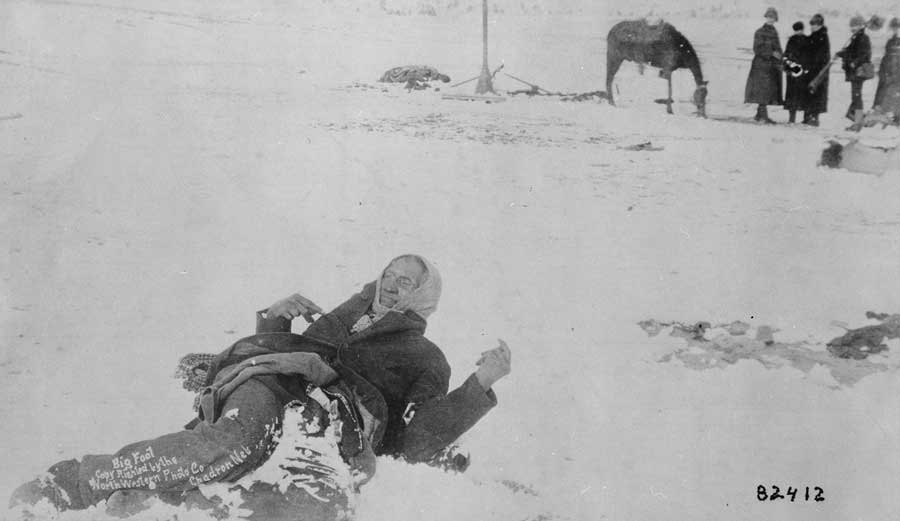 Lakota Chief Spotted Elk, better known as Big Foot of the Miniconjou band, froze to the ground after dying at Wounded Knee Creek in South Dakota. (Photo courtesy of the National Archives.)
Lakota Chief Spotted Elk, better known as Big Foot of the Miniconjou band, froze to the ground after dying at Wounded Knee Creek in South Dakota. (Photo courtesy of the National Archives.)
As Catches’ ancestor fled, frozen bodies littered the makeshift battlefield stretching for miles, often called the “killing field” among Lakotas. The cold, stiff corpse of Spotted Elk, nicknamed Chief Big Foot of the Miniconjou band, was frozen to the ground. The Army dug mass graves, and soldiers stripped down some of their bodies to steal “ghost shirts” as souvenirs.
“And we don’t know how many other children ran from Wounded Knee together, unsupervised, and all of this because somebody wanted land,” Catches tells The War Horse. “Russia wants Ukraine for the land and the resources. We became displaced for the very same reason; we’re still displaced.”
‘They Didn’t Hold Themselves Accountable’
Manny Iron Hawk sends thoughts, prayers, and even a bit of his broken heart around the globe from the Cheyenne River Indian Reservation in South Dakota to the Ukrainians 5,000 miles away.
“I hope maybe we can somehow send a message to them, to the people of Ukraine, that we have similar histories,” the enrolled member of Cheyenne River Sioux Tribe tells The War Horse, “that we’ve gone through some very hard times, massacres, and whatnot.”
As co-chair of HAWK 1890, which stands for Heartbeat at Wounded Knee 1890—a Native-led grassroots group of living descendants—Iron Hawk watches the modern-day struggle for Ukrainian sovereignty. A fourth-generation direct descendant of Ghost Horse, who died at Wounded Knee with his son, Iron Hawk says history is repeating itself with “a lot of children getting killed over there,” along with older Ukrainians, some of whom “are not fleeing fast enough.”
“They’re Indigenous, they’re tied to the land, so they want to stay there and fight—if it costs them their lives,” Iron Hawk says of the Ukrainians. “They believe in something that comes from our heart.”
Even with spotty cellular and Wi-Fi service scattered across the splintered South Dakota reservations, seeing human rights violations unfold on their televisions and mobile screens in real time reminds residents of their own bloodied history.
“They’re willing to kill indiscriminately in order to create shock and awe,” Wendell Yellow Bull, an enrolled member of the Oglala Sioux Tribe, tells The War Horse. “What they did, they did here. And the political was to justify why they did the atrocities.”
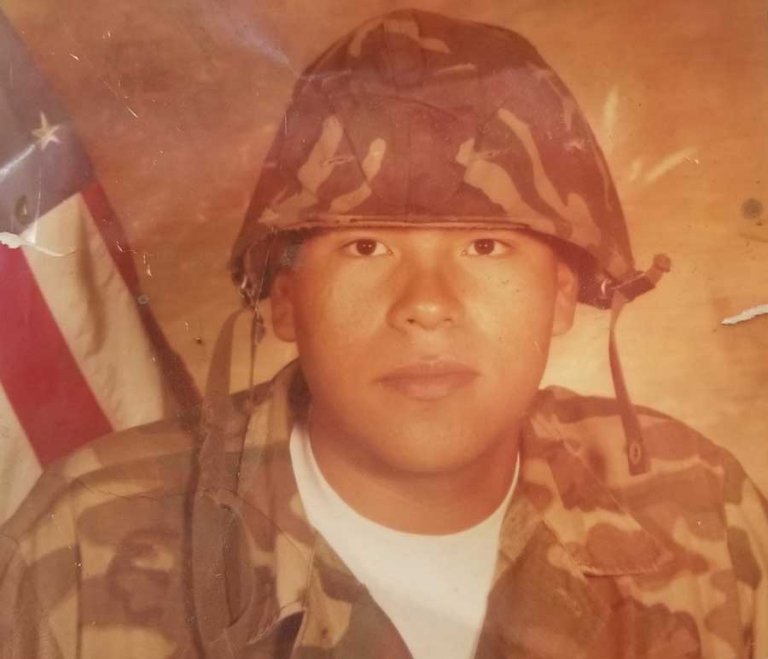 Wendell Yellow Bull, a lifelong resident of the Pine Ridge Indian Reservation, became a lance corporal while serving in the 4th Marines’ 2nd Battalion, better known as the “Magnificent Bastards,” in the years after the Vietnam War. (Photo courtesy of Wendell Yellow Bull.)Joseph Horn Cloud was a Wounded Knee survivor and Yellow Bull’s great-grandfather. Yellow Bull never lived anywhere but Pine Ridge Indian Reservation—except when he joined the Armed Forces.
Wendell Yellow Bull, a lifelong resident of the Pine Ridge Indian Reservation, became a lance corporal while serving in the 4th Marines’ 2nd Battalion, better known as the “Magnificent Bastards,” in the years after the Vietnam War. (Photo courtesy of Wendell Yellow Bull.)Joseph Horn Cloud was a Wounded Knee survivor and Yellow Bull’s great-grandfather. Yellow Bull never lived anywhere but Pine Ridge Indian Reservation—except when he joined the Armed Forces.
In 1979, after his first attempt to pass the GED test at age 17, he enlisted in the U.S. Marine Corps, earning the rank of lance corporal. He was sent to Okinawa, Japan, with the 2nd Battalion, 4th Marines, better known as the “Magnificent Bastards.” He trained infantry units assigned to rescue prisoners of war long after the Vietnam War ended. But today, his perspective has changed: He sees himself as a intruder venturing into Asia with the “Stars and Stripes” stitched onto his uniform sleeve.
The Oglala Lakota county commissioner says if Americans demand that Russia be punished for its military misconduct and allegations of war crimes in Ukraine, the United States should correct its own record.
“They didn’t hold themselves accountable because they declared it a battle,” Yellow Bull says, “They wanted the land. … They wanted revenge.”
Dwight Mears, a retired U.S. Army major and former history professor at West Point, says an investigation “did, in fact, uncover war crimes” in the days and months after the mass shooting in South Dakota. But the findings fell on deaf ears and were ignored by those highest in the chain of command.
One case stands out among the rest: Three miles away from the battlefield, the bodies of a Lakota woman and three children—two girls and a boy—of the Big Foot band were discovered behind a bush.
Major Peter Dumont Vroom, the inspector general, investigated Wounded Knee for Secretary of War Redfield Proctor, according to Mears. Vroom sought to find out if civilians died unnecessarily.
The soldiers appear to have coordinated their stories: “Most of them just blamed the Natives and said that this was treachery and they were the ones that killed their own civilians,” Mears said.
Major J. Ford Kent, 4th Infantry assistant inspector general, blamed the Lakotas for the civilian casualties.
“I am of opinion that, under the circumstances, all care was taken after the Indians made their first break to preserve the lives of non-combatants,” he wrote in a sworn statement, “and that the fact that several women and children were killed and wounded could be ascribed only to the fault of the Indians themselves, and force of unavoidable and unfortunate circumstances.”
But not all of the Army believed him, including Gen. Nelson Appleton Miles, who requested the investigation.
“I have never heard of a more brutal, cold-blooded massacre than that at Wounded Knee,” he wrote in a personal letter. “About two hundred women and children were killed and wounded; women with little children upon their backs, and small children powder-burned by the men who killed them being so near as to burn the flesh and clothing with the powder of their guns, and nursing babes with five bullet holes through them.”
First Sgt. Herman Gunther of the 7th Cavalry’s Troop D remembered chasing the fleeing Natives, and “hunting for the rest” through the ravine after the bloodshed stopped.
A woman and three children crouched in the low shrubbery. Before the troops began to shoot at their unconfirmed targets, soldiers and their commanding officers allegedly shouted out, “Hau Kola … Hau Kola …”—a Lakota term meaning “hello friend.”
No one answered, which isn’t surprising considering so many had just been killed, Mears says. So the soldiers fired. The girls were young, between the ages of six and eight. The oldest girl fell in front of her mother, who was shot beneath her right shoulder blade. The youngest daughter collapsed from a shot to her back and clung to her mother’s skirt.
The boy, who was as young as 10, was shot in the left side of his head.
Blacksmith Maurice Carey, an enlistee who had joined Troop D three weeks before the massacre, executed the boy, who was apparently still alive after the initial volley, while the rest of the soldiers wandered through the valley in search of more runaways.
Retired U.S. Army Brig. Gen. Edward Settle Godfrey’s letter to the Army War College, written 40 years after the Wounded Knee investigation concluded, shows he saw Carey take hold of the boy’s head and lift him up, only to see his eyes suddenly flicker open. His unexpected movements frightened the new recruit, who shot the boy through the head in “self defense,” out of fear for his own life, Carey later told Godfrey. But no weapons were found near any of the bodies.
While several soldiers said the bush was too thick for them to identify the unarmed Lakota woman and children, the report found that the shrubbery had no leaves left on its branches, according to Mears’ research.
“It does not appear that this killing had any connection with the fight at Wounded Knee,” War Secretary Proctor wrote, absolving the U.S. Army from any responsibility for the civilian murders.
War Department officials “worried that it was going to taint the ability to whitewash Wounded Knee and say that it had been thoroughly investigated” following the Army’s internal inquiry of the woman and her children’s deaths—one that was “pretty thorough by that day’s standards,” Mears says, “not so much by present day”—so they said it was unrelated to Wounded Knee.
Neither Forsyth, a West Point graduate, nor any of his men were prosecuted after the inquiry concluded. Although the secretary of war said the soldiers committed crimes, Proctor’s verdict allowed the Army colonel to regain control of his command following a brief leave of absence during the investigation.
‘Awarding Medals Changed the Narrative’
Soldiers who fired indiscriminately and aimed at children, as well as mostly unarmed Lakota men, were recommended for the Medal of Honor. Ultimately, 20 soldiers who participated in the massacre at Wounded Knee received the Medal of Honor. To put that in perspective, 25 Medals of Honor have been awarded in the 21 years since the 9/11 terror attacks.
After Wounded Knee, 2nd Lt. Harry Hawthorne received a medal for his gallantry, his coolness, his discretion, and the way he handled his guns, Jerry Green writes for the Nebraska State Historical Society. John Clancy, who was court-martialed eight times while he served in the Army and ultimately was dishonorably discharged, received his medal for rescuing wounded soldiers.
After Wounded Knee, the Army added to the requirements for the medal: One could not receive it if they had been court-martialed since the action.
Other soldiers received medals for “gallantry,” or “bravery.” One such soldier fatally shot himself in the head two years after Wounded Knee.
Yet another soldier received a medal for “conspicuous bravery in rounding up and bringing to the skirmish line a stampeded pack mule,” Green writes. Another soldier earned his medal for “voluntarily leaving his work as a cook.”
Medals predating the Army’s modernization, including those issued at Wounded Knee, were given without any guiding statutory regulations. Many of the Wounded Knee recipients would have failed to meet the service threshold requirements set by new modern statutes that dictated Medal of Honor eligibility, Mears says.
“Awarding medals was an excellent way to change the narrative,” Mears says, adding that the Army’s 7th Cavalry sought to “shore up their legacy.”
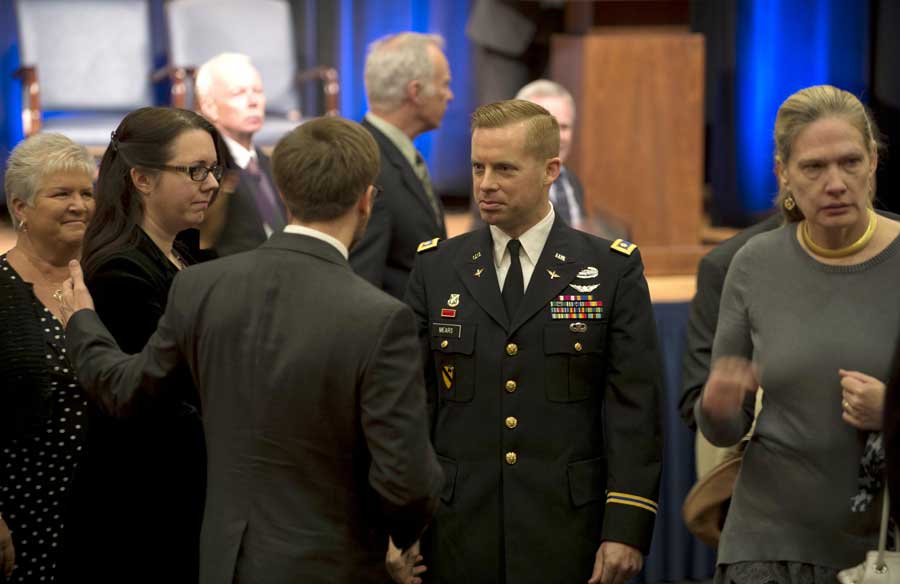 Retired U.S. Army Maj. Dwight Mears has always been fascinated by service awards as an academically trained historian who once taught at West Point Military Academy. He has helped the families of roughly 200 veterans apply for and earn military honors, most of which were posthumous distinctions, since the 1990s. (Photo courtesy of the Department of Defense.)
Retired U.S. Army Maj. Dwight Mears has always been fascinated by service awards as an academically trained historian who once taught at West Point Military Academy. He has helped the families of roughly 200 veterans apply for and earn military honors, most of which were posthumous distinctions, since the 1990s. (Photo courtesy of the Department of Defense.)
Twelve years after Wounded Knee, the 1916 Medal of Honor Review Board revoked 911 medals after they assessed all 2,625 medals given since the award’s founding in 1862. It’s the only time Army medals were rescinded, authorized by an act of Congress.
The Wounded Knee soldiers all kept their medals.
Mears has worked to gather academics to individually assess each Medal of Honor awarded for Wounded Knee. His has identified at least 13 cases that seem to be “facially revocable,” meaning the actions that led to the medals were questionable. But he needs more buy-in from his peers in academia.
Mears, who wrote The Medal of Honor: The Evolution of America’s Highest Military Decoration, says the Wounded Knee awards weren’t earned.
“Just about everyone with a Ph.D. after their name basically agrees that the Army should not have awarded those medals, even under their criteria that existed at that time, that it was unwise, and that probably some of those officials knew it—if not the people themselves,” Mears says.
“They were intentionally trying to push a false version of history, and so you’re not rewriting history by undoing that,” he adds. “You’re correcting history to base it on facts, and that’s like Wounded Knee because the status quo is untenable.”
‘Act Swiftly to Revoke These Undue Honors’
In early November, Sens. Warren and Jeff Merkley, D-Ore., led efforts to send a letter with Kahele and 15 other U.S. senators to the president, asking him to “act swiftly to revoke these undue honors” to “right this historical wrong and begin to heal the lasting wounds of many Native American descendants today.”
“This was something I felt, as an Indigenous, Native Hawaiian, that it was my responsibility to act as a voice for not only my ancestors, but the ancestors of all Indigenous peoples of this country who have, for over 100 years, been silenced on this issue—like those that were silenced at Wounded Knee,” Kahele says.
Although federal lawmakers argue the president has the authority to revoke honors when deemed appropriate, the process to rescind military decorations is a fairly modern and even unprecedented one, Mears says.
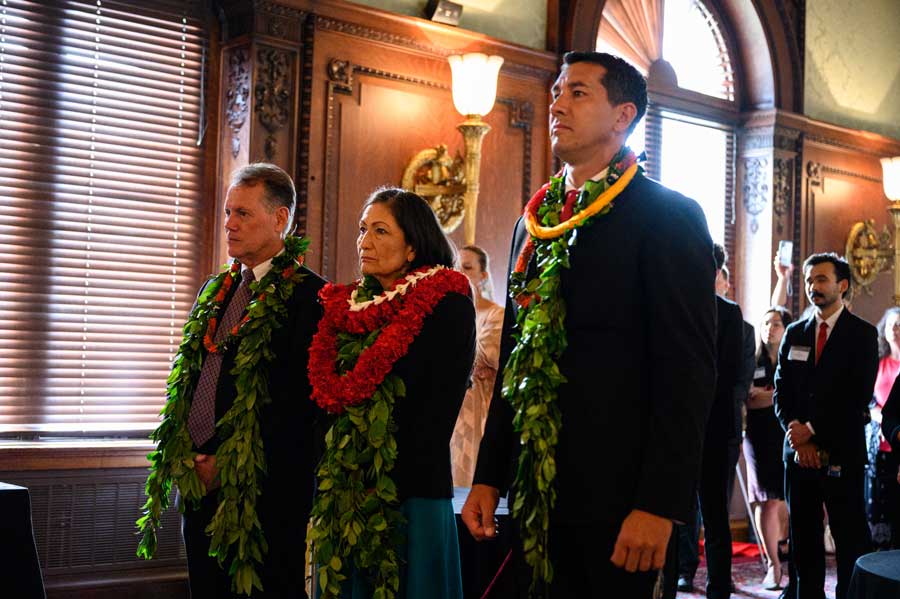 Reps. Ed Case, D-Hawaii; Deb Haaland, D-N.M., and Kai Kahele, D-Hawaii, celebrate the 100th anniversary of the Hawaiian Homes Commission Act in 2020. (Photo courtesy of Rep. Kai Kahele.)
Reps. Ed Case, D-Hawaii; Deb Haaland, D-N.M., and Kai Kahele, D-Hawaii, celebrate the 100th anniversary of the Hawaiian Homes Commission Act in 2020. (Photo courtesy of Rep. Kai Kahele.)
Since there’s no statute barring any sitting president from revocating military awards, including the Medal of Honor, Mears says “it’s a safe bet” Biden has the authority to revoke the medals.
However, Defense Department policy guidelines outline reasons for revocation. In most cases, evidence must prove fraud, material error, or the misrepresentation of facts relating to the conduct of service, Mears says.
“The Department of Defense sometimes struggles with how to address and provide redress to things that have been done to our Native communities in the past,” Kahele says. “Native Hawaiians are no different.”
‘It’s Very Personal to Us’
After sending the letter in 2019, Semans and his wife Barbara began bringing at least 100 direct descendants of the 131-year-old massacre together across three reservations through Four Directions, a South Dakota-based nonpartisan organization leading Native voting rights initiatives nationwide.
Like their ancestors, the living descendants are resilient and equally patient. It took a century for Hill lawmakers to acknowledge Wounded Knee as a “terrible tragedy” in a resolution the 101st Congress passed in 1990.
In 2001, the Cheyenne River Sioux Tribal Council called upon the United States to revoke the Medals of Honor after passing a resolution demanding the Army “renounce the issuance of said medals” and proclaim that the military honors are “null and void” given “the atrocities committed” upon unarmed noncombatants.
At the National Congress of American Indians annual session 18 years later, held in Albuquerque, New Mexico, they adopted a resolution in support of the Remove the Stain Act by calling upon Congress and the president to “exercise a sense of humanity.” The 2019 resolution says commending the Army’s 7th Cavalry with military praise “dishonors the Medals of Honor and is a message of hostility and genocide by the United States against the Great Sioux Nation and our precious relatives who were massacred at Wounded Knee.”
“I think as military service members, it’s very personal to us,” Kahele says. “And it’s something that even if it happened 100-plus years ago, it needs to be addressed.”
Though the Democrats control Congress, and President Joe Biden issued an official campaign promise to rescind Medals of Honor issued at Wounded Knee, the highest military decorations still remain intact for U.S. soldiers who participated in a massacre.
The Remove the Stain Act legislation has appeared, spanning across two congressional sessions. All attempts to enact the measure into law have failed thus far. However, Four Directions helped coordinate two presidential forums, centering Native communities and issues at the forefront of conversations during the latest race for the White House.
During one such session, Bret Healy, a non-Native ally who serves as COO of Four Directions, says Biden “without reservation” made a written commitment to revoke the medals.
“He didn’t have any caveats in his answer,” Healy says. Four Directions released the official campaign memo to The War Horse.
“We have a lot of work ahead of us, but I know we’re up to the task,” Biden said in the document, dated Jan. 15, 2020.
As a presidential candidate, Biden said the nation’s highest military decoration being bestowed to honor a massacre is “abhorrent to those very ideals and lessens what the award represents in integrity and personal sacrifice for all others who have received it.”
Vice President Kamala Harris also backed the Remove the Stain Act, telling Marcella LeBeau, a retired Army nurse and elder of the Cheyenne River Sioux Tribe who served as a nurse at the Battle of the Bulge in World War II, that “history has to reflect fact” during a Four Directions presidential forum in 2019.
Semans hoped the 102-year-old Lakota community leader would see their dreams become reality. But LeBeau died in November, a few weeks after federal lawmakers renewed their efforts by pressing the Biden administration to act.
“The Biden-Harris administration considers the Wounded Knee Massacre a stain on our nation’s history and we continue to review this issue,” an assistant press secretary for the White House’s National Security Council told The War Horse in an email.
‘It’s Gaining National Prominence’
But the fight for change continues to be a struggle, even as the nation sees bases renamed and statues of Confederate generals removed. The veterans’ efforts were stalled from the outset, Semans says, when they “lost [their] lineup.” Key lawmakers left Congress after that session in 2019, most notably Deb Haaland, a former Democratic congresswoman from New Mexico. She joined the Biden administration as secretary of the interior department, becoming the first Indigenous Cabinet member in U.S. history.
So Four Directions approached Kahele.
“The Wounded Knee Massacre, to me, is a part of a larger series of military encounters and atrocities between Native Americans and the U.S. military,” Kahele says. “It’s something that we have to address as a nation, and that was my intent by getting the Wounded Knee amendment into the [National Defense Authorization Act].”
Last year, Congress inserted an amendment into the 2022 NDAA, adopting language from the reintroduced Remove the Stain Act. The original bill, which was initially introduced on the Battle of Little Bighorn’s anniversary in June 2019, would rescind the Wounded Knee Medals of Honor.
Although the Kahele Amendment passed in the House last September, it had been scrubbed from the $770 billion defense budget during the Senate conferencing period by early December.
“I’ll be pushing again this year in the upcoming NDAA to get that amendment in and send it back to the conference committee, and push for it to stand—the final version of the bill,” Kahele says.
He reintroduced the Remove the Stain Act, amending the House’s 2023 National Defense Authorization Act upon its passage in July.
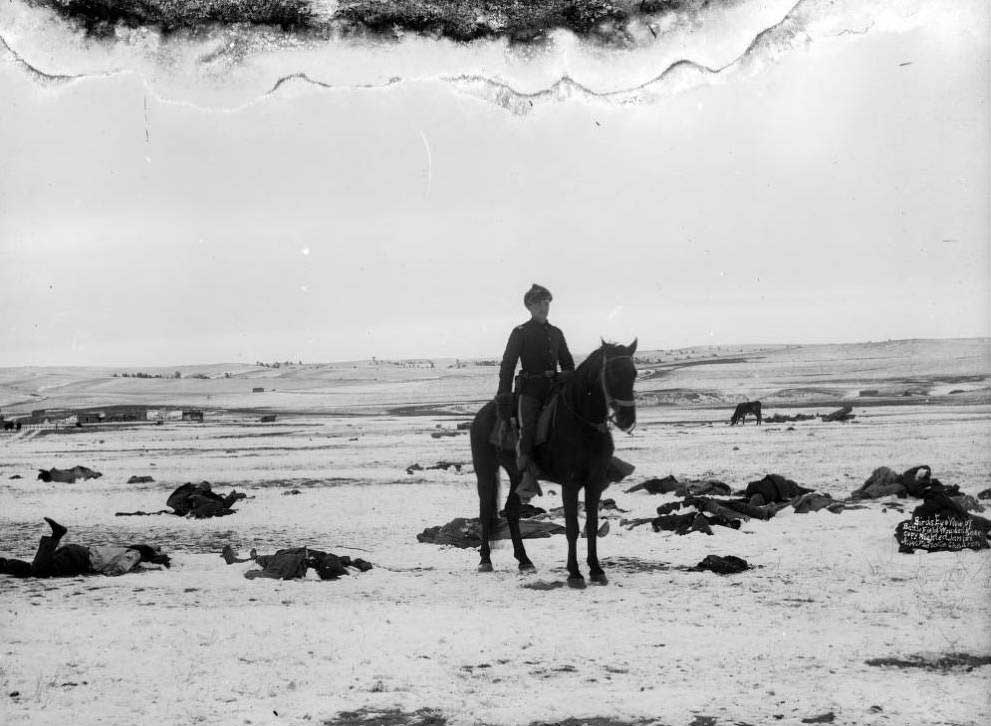 Lt. Sydney A. Cloman, who accompanied the burial party and drew the official map of the scene, sits on horseback among the scattered, frozen bodies of Lakota Sioux, including Chief Big Foot, throughout the Pine Ridge Indian Reservation. (Photo courtesy of Denver Public Library Special Collections.)
Lt. Sydney A. Cloman, who accompanied the burial party and drew the official map of the scene, sits on horseback among the scattered, frozen bodies of Lakota Sioux, including Chief Big Foot, throughout the Pine Ridge Indian Reservation. (Photo courtesy of Denver Public Library Special Collections.)
The Senate and House Armed Services conference chairs sought to “encourage the Secretary of Defense to review these medals,” as well as to provide a briefing, in a directive outlined through the joint explanatory statement accompanying the 2022 NDAA. It stated that the medals were “awarded at the prerogative of the President of the United States, not the Congress.”
It’s still unclear if Defense Secretary Lloyd Austin is assessing the status of the medals even after Congress advised him to do so more than six months ago. Two Defense Department spokespeople were unable to answer whether Austin had tasked his agency to review the medals since the department “does not discuss internal, deliberative processes.”
But Mears says the decision for revocation should be bipartisan: “If you want to make this ironclad as possible, the best way to do it would be to pass a bill … a bipartisan bill, optimally authorizing a review that would seek both scholarly and DOD input.”
Kahele sees no reason for more debate, and says allowing Biden to revoke the awards is “the quickest, easiest way.”
“We don’t need to conduct an investigation into Wounded Knee,” Kahele says, echoing the sentiments of the direct descendants. “Our military and nation committed atrocities there. These medals need to be and should be, and I believe will be, revoked.”
Rep. Dusty Johnson, a two-term Republican representing South Dakota’s at-large congressional district, agrees with the Hawaiian congressman. “I do not believe Congress has, or should have, the authority to unilaterally rescind or award military honors, regardless of the circumstances,” Johnson writes in an internal letter sent to Biden, dated June 24, 2021, obtained by The War Horse.
The South Dakota House Republican cites the Article XXVI Sec. 175 of the Regulations for the Army published in 1889, a statute that reads: “Medals of honor will be awarded, by the President, to officers or enlisted men who have distinguished themselves in action.”
“I request that you review these and other regulations and statutes to determine whether you, as Commander in Chief, have both the sole authority to issue Medals of Honor as well as rescind Medals of Honor,” Johnson wrote.
Several members of Congress in both chambers, including Sen. Tina Smith, D-Minn.; Warren; and Rep. Sharice Davids, D-Kan., agreed; they told The War Horse in individually written statements.
Tribal leaders also agreed. Kevin Killer, president of the Oglala Sioux Tribe, served as a Democratic lawmaker in the South Dakota House of Representatives for a decade, representing a district that encompassed the Pine Ridge Indian Reservation.
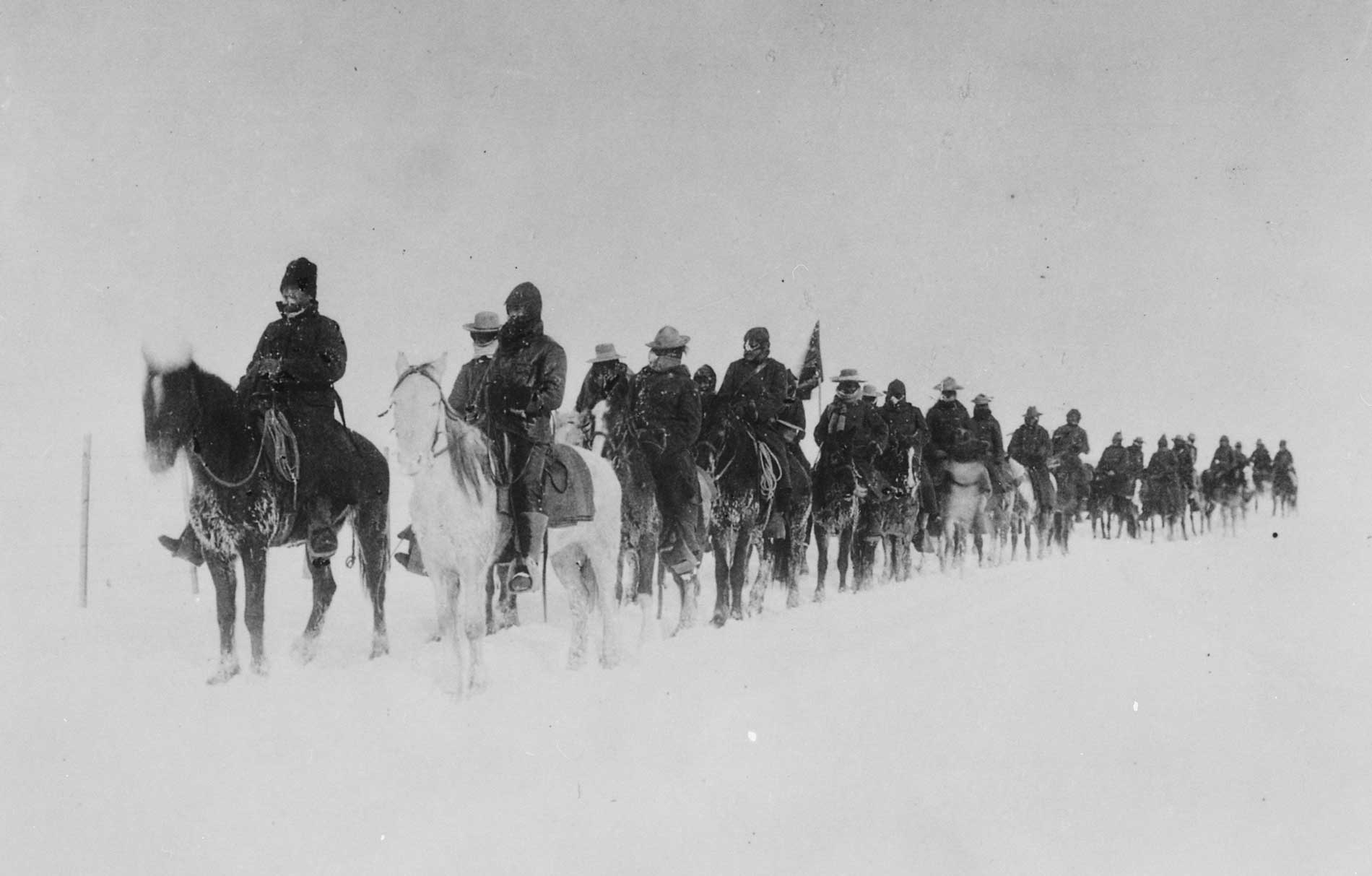 Lt. Edward W. Casey’s Cheyenne Army Scouts ride on horseback, returning from the Pine Ridge Indian Reservation during a blizzard. (Photo courtesy of the National Archives.)
Lt. Edward W. Casey’s Cheyenne Army Scouts ride on horseback, returning from the Pine Ridge Indian Reservation during a blizzard. (Photo courtesy of the National Archives.)
The South Dakota State Senate unanimously adopted a resolution in February 2021 calling on the federal government to investigate and rescind the Medals of Honor. A cultural shift has transformed the state legislature since he held office, Killer says.
“I think with Wounded Knee coming to light, it’s been a lot better trying to get people to understand that history,” Killer tells The War Horse.
“But I think in the past 10 years, it’s been growing, growing—gaining national prominence,” Killer says. “I think that national awareness wasn’t there 10 years ago.”
Scott Herman, president of the Rosebud Sioux Tribe, asked that federal lawmakers venture westward to visit their reservations, meet the descendants, and see the memorial sites dedicated to their slain ancestors, he tells The War Horse.
Marlis Afraid of the Hawk, an enrolled member of the Oglala Sioux Tribe, and the rest of her family have been fighting three lifetimes for justice. Her grandfather, Richard Afraid of the Hawk, who survived the massacre at the age of 13, testified before Congress seeking reparations and the removal of medals in 1934. Her father, David Afraid of the Hawk, also fought for the change.
The Lakota great-grandmother says she hopes her children and grandchildren will one day reap the benefits of her family’s struggle—even if she doesn’t live to see it herself.
“I’m just hoping that everything will work out, you know, for all the descendants, and especially for my grandkids and my great-grandkids,” Afraid of Hawk says. “I don’t let them forget that because, you know, like I said, every time we get together with all my grandkids, I tell them: Be proud of where you come from.”
On the Pine Ridge Indian Reservation, memories inherited from atrocities committed more than a century ago still trouble Iron Hawk, he says, speaking of intergenerational trauma. He wants to break that cycle for the sake of his children.
“I heard the stories of my mother when she reads her grandma’s stories, and they also cry, you know, so somehow that transferred to me,” Iron Hawk says. “I didn’t want that for my children. It’s going to have to stop—healing has to begin right now.”
Gabriel Pietrorazio is a national-award-winning journalist who covers Indigenous affairs, food and agriculture, and politics, as well as crime and justice. He earned a master’s degree from the Philip Merrill College of Journalism at the University of Maryland, College Park, in 2021.
Editor's Note: This article first appeared on The War Horse, an award-winning nonprofit news organization educating the public on military service. Subscribe to their newsletter.
Help us defend tribal sovereignty.
At Native News Online, our mission is rooted in telling the stories that strengthen sovereignty and uplift Indigenous voices — not just at year’s end, but every single day.
Because of your generosity last year, we were able to keep our reporters on the ground in tribal communities, at national gatherings and in the halls of Congress — covering the issues that matter most to Indian Country: sovereignty, culture, education, health and economic opportunity.
That support sustained us through a tough year in 2025. Now, as we look to the year ahead, we need your help right now to ensure warrior journalism remains strong — reporting that defends tribal sovereignty, amplifies Native truth, and holds power accountable.
 The stakes couldn't be higher. Your support keeps Native voices heard, Native stories told and Native sovereignty defended.
The stakes couldn't be higher. Your support keeps Native voices heard, Native stories told and Native sovereignty defended.
Stand with Warrior Journalism today.
Levi Rickert (Potawatomi), Editor & Publisher
